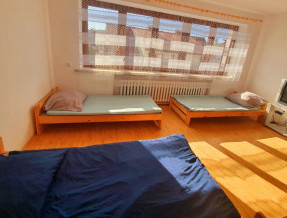Kraków
Kraków, perła architektoniczna Polski, przyciąga rzesze turystów zarówno z kraju, jak i z różnych zakątków świata, stając się jednym z najbardziej pożądanych miejsc do odwiedzenia na mapie międzynarodowej turystyki. Położony nad malowniczym zakolem Wisły, jest drugim co do wielkości miastem w Polsce, zarówno pod względem liczby mieszkańców, jak i powierzchni. Znany z przeszłości jako stolica Polski, Kraków nadal zachowuje dziedzictwo narodowe jako miejsce koronacji i pochówku królów.
Zamek Królewski na Wawelu, z jego majestatyczną architekturą, dominuje nad panoramą miasta, oferując zapierające dech w piersiach widoki, zwłaszcza gdy podziwiane z lotu ptaka za pomocą drona. W samym sercu Krakowa, otoczone zabytkowymi kamienicami i tętniącymi życiem uliczkami, znajduje się Stare Miasto - klejnot architektoniczny, z Rynek Główny i słynnymi Sukiennicami. Kościół Mariacki, z jego gotyckim splendorem, jest świadectwem bogatej historii religijnej regionu.
Niezwykle malownicze są też inne dzielnice miasta, takie jak Kazimierz, dawna żydowska dzielnica, pełna historii i kultury, czy Nowa Huta, przykład socrealistycznej architektury. Kraków, wpisany na listę światowego dziedzictwa UNESCO, jest żywym muzeum, gdzie przeszłość i teraźniejszość przenikają się na każdym kroku.
To nie tylko skarbnica zabytków, ale również miejsce spotkań kulturalnych i artystycznych. Kraków tętni życiem, oferując niezliczone restauracje, kawiarnie i puby, gdzie można doświadczyć lokalnych smaków i atmosfery. Charakterystycznym elementem krajobrazu są uliczni artyści, dodający miastu niepowtarzalnego uroku, a pod Mariackim niemal zawsze można kupić świeże kwiaty. Jest to miasto, które zaprasza do eksploracji swoich zakamarków i odkrywania jego wielowarstwowych opowieści.
Atrakcje w Krakowie - Co warto zwiedzić w Krakowie?
Kraków, znany ze swojego bogatego dziedzictwa kulturowego i architektonicznego, kryje w sobie wiele miejsc wartych odkrycia.
- Wieża Ratuszowa - idealne miejsce na rozpoczęcie przygody z Krakowem, oferujące panoramiczny widok na miasto.
- Podziemia Rynku - fascynująca podróż w głąb historii krakowskiego rynku.
- Sukiennice - serce Rynku Głównego, pełne zabytków i lokalnych sklepików.
- Pomnik Adama Mickiewicza - kultowe miejsce spotkań i symbol krakowskiego Rynku.
- Bazylika Mariacka i Ołtarz Wita Stwosza - jeden z najbardziej znanych zabytków Krakowa z niezwykłym ołtarzem.
- Kościół św. Wojciecha - mały, ale pełen historii kościół na Rynku Głównym.
- Mały Rynek - urokliwe miejsce, idealne do krótkiego odpoczynku.
- Muzeum Książąt Czartoryskich - muzeum sztuki z niezwykłymi eksponatami.
- Barbakan i Brama Floriańska - pozostałości średniowiecznych umocnień miasta.
- Dom Jana Matejki - dom słynnego malarza, obecnie muzeum.
- Zamek Królewski na Wawelu - wizyta w dawnej rezydencji królów Polski.
- Planty Krakowskie - spacer wśród zielonych alejek wokół Starego Miasta.
- Ogród Botaniczny Uniwersytetu Jagiellońskiego - oaza spokoju i piękna przyrody.
- Park im. Henryka Jordana - idealne miejsce na odpoczynek w zieleni.
- Kazimierz Żydowski - historyczna dzielnica z unikalnym klimatem.
- Muzeum Nowej Huty - poznanie historii jednego z najmłodszych dzielnic Krakowa.
- Kopiec Kościuszki - miejsce z pięknym widokiem na miasto.
- Lustrzany Labirynt - zabawa i wyzwanie dla całej rodziny.
- Ogród Zoologiczny w Krakowie - spotkanie z różnorodnością zwierząt.
- Żywe Muzeum Obwarzanka - interaktywna lekcja historii i pieczenia obwarzanków.
- Zwiedzaj Kraków z innej perspektywy:
- Dorożka - romantyczny i tradycyjny sposób na zwiedzanie.
- Melexy - nowoczesne i wygodne pojazdy do zwiedzania miasta.
Pamiętajmy, że Kraków oferuje wiele więcej i każdy znajdzie coś dla siebie w tym niezwykłym mieście. To tylko propozycje, które można dostosować do indywidualnych preferencji i zainteresowań. Kraków zawsze zachwyca swoją różnorodnością i historią.
Jakie noclegi w Kargowie wybrać?
Kraków, jako jeden z najbardziej urokliwych miast w Polsce, oferuje szeroką gamę noclegów, dopasowanych do różnorodnych potrzeb i preferencji. Znajdujące się w centrum noclegi w Krakowie to idealne rozwiązanie dla tych, którzy pragną być blisko najważniejszych atrakcji turystycznych, takich jak Rynek Główny czy Wawel. Dla osób szukających bardziej ekonomicznych opcji, Kraków oferuje tanie noclegi w samym sercu Starego Miasta, gdzie historia łączy się z nowoczesnością. Popularne są również kwatery i apartamenty, które zapewniają komfort i prywatność, będąc doskonałą alternatywą dla tradycyjnych hoteli.
Jeśli planujesz pobyt z rodziną, Kraków ma do zaoferowania noclegi przyjazne dzieciom, często z dodatkowymi udogodnieniami, takimi jak place zabaw czy specjalne menu. Dla podróżujących ze zwierzętami domowymi, wiele miejsc oferuje możliwość zabrania ze sobą pupila. Nie brakuje także opcji luksusowych, takich jak noclegi z basenem, sauną, jacuzzi czy ekskluzywnymi spa.
Dla osób podróżujących koleją, istnieją noclegi w Krakowie blisko dworca PKP, zapewniając łatwy dostęp do transportu publicznego i głównych atrakcji miasta. Z kolei bliskość aquaparku czy zabytkowego centrum to atuty, które cenią sobie zwłaszcza rodziny z dziećmi oraz młodzież. Atrakcyjne są również oferty noclegów z wyżywieniem, ze śniadaniem, gdzie goście mogą delektować się lokalnymi specjałami bez konieczności opuszczania obiektu.
W krakowskiej ofercie nie brakuje również pensjonatów, pokoi 2-osobowych, domków, willi oraz ośrodków wypoczynkowych, które zapewniają różnorodne warunki zakwaterowania, od podstawowych po bardziej wyszukane. Niezależnie od tego, czy szukasz intymnej atmosfery pensjonatu, wygody apartamentu, czy uroków rustykalnego domku, Kraków ma coś do zaoferowania każdemu gościowi.
Pamiętaj, że Kraków to miasto, które potrafi zaskoczyć i oczarować, a odpowiednio dobrany nocleg tylko wzmocni Twoje doświadczenia podczas pobytu w tym niezwykłym mieście.
Które obiekty noclegowe w Krakowie są najlepsze na pobyt z dzieckiem?
Wybierając obiekty noclegowe w Krakowie na pobyt z dzieckiem, warto zwrócić uwagę na te, które oferują specjalne udogodnienia dla najmłodszych. Hotele z placami zabaw, pokojami rodzinnymi i menu dostosowanym do potrzeb dzieci zapewniają komfortowy i bezpieczny pobyt dla całej rodziny. Ponadto, obiekty położone blisko atrakcji turystycznych, takich jak Park Wodny, Ogród Zoologiczny czy Muzeum Lotnictwa, są idealnym wyborem dla rodzin pragnących połączyć wygodę zakwaterowania z atrakcjami dla dzieci.
Ile kosztuje weekend w Kargowie?
Planując weekendowy pobyt w Krakowie, warto mieć na uwadze, że średni koszt noclegu oscyluje wokół 120 zł za dobę. Cena ta może się różnić w zależności od standardu obiektu, jego lokalizacji oraz dodatkowych udogodnień oferowanych przez hotel czy pensjonat. Hotele zlokalizowane w centrum miasta lub w pobliżu głównych atrakcji turystycznych mogą mieć nieco wyższe stawki, jednak zapewniają szybki dostęp do zabytków i kultury Krakowa. Tanie noclegi można znaleźć w bardziej oddalonych dzielnicach, co może być idealnym rozwiązaniem dla podróżujących z ograniczonym budżetem. Ważne jest, aby przed rezerwacją dokładnie sprawdzić oferty i wybrać opcję, która najlepiej odpowiada indywidualnym potrzebom i oczekiwaniom.
































